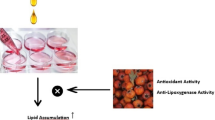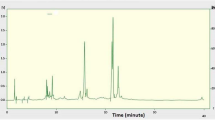Abstract
Lead is a heavy metal widely distributed in the environment. Lead is a ubiquitous environmental toxin that is capable of causing numerous acute and chronic illnesses. Human and animal exposure demonstrates that lead is nephrotoxic. However, attempts to reduce lead-induced nephrotoxicity were not found suitable for clinical use. Recently, flaxseed oil (FXO), a rich source of ω-3 fatty acids and lignans, has been shown to prevent/reduce the progression of certain types of cardiovascular and renal disorders. In view of this, the present study investigates the protective effect of FXO on lead acetate (PbAc)-induced renal damage. Rats were pre-fed normal diet and the diet rich in FXO for 14 days, and then, four doses of lead acetate (25 mg/kg body weight) were administered intraperitoneally while still on diet. Various serum parameters, enzymes of carbohydrate metabolism, brush border membrane (BBM), and oxidative stress were analyzed in rat kidney. PbAc nephrotoxicity was characterized by increased serum creatinine and blood urea nitrogen. PbAc increased the activities of lactate dehydrogenase and NADP-malic enzyme, whereas it decreased malate and glucose-6-phosphate dehydrogenase, glucose-6-phosphatase, fructose-1, 6-bisphosphatase, and BBM enzyme activities. PbAc caused oxidant/antioxidant imbalances as reflected by increased lipid peroxidation and decreased activities of superoxide dismutase, glutathione peroxidase, and catalase. In contrast, FXO alone enhanced the enzyme activities of carbohydrate metabolism, BBM, and antioxidant defense system. FXO feeding to PbAc-treated rats markedly enhanced resistance to PbAc-elicited deleterious effects. In conclusion, dietary FXO supplementation ameliorated PbAc-induced specific metabolic alterations and oxidative damage by empowering antioxidant defense mechanism and improving BBM integrity and energy metabolism.



Similar content being viewed by others
References
Barbier O, Jacquillet G, Tauc M, Cougnan M, Poujeol P (2005) Effect of heavy metals on, and handling by kidney. Nephron Physiol 99:105–110
Loghman-Adham M (1997) Renal effects of environmental and occupational lead exposure. Environ Health Perspect 105:928–939
Damek-Poprawa M, Sawicka-Kapusta K (2004) Histopathological changes in the liver, kidneys, and testes of bank voles environmentally exposed to heavy metal emissions from the steelworks and zinc smelter in Poland. Environ Res 96:72–78
Bressler J, Kim KA, Chakraborti T, Goldstein G (1999) Molecular mechanisms of lead neurotoxicity. Neurochem Res 24:595–600
Khalil-Manesh F, Gonick HC, Weiler EW, Prins B, Weber MA, Purdy RE (1993) Lead-induced hypertension: possible role of endothelial factors. Am J Hypertens 6:723–729
Khalil-Manesh F, Gonick HC, Cohen AH (1992) Experimental model of lead nephropathy. I. Continuous high-dose lead injection. Kidney Int 41:1192–1203
Khalil-Manesh F, Gonick HC, Cohen A (1992) Experimental model of lead nephropathy. II. Effect of removal from lead exposure and chelation treatment with dimercaptosuccinic acid (DMSA). Environ Res 58:35–54
Fowler BA, Kimmel CA, Woods JS, Mc Connel EE, Grant LD (1980) Chronic low level lead toxicity in the rat: III. An integrated assessment of long term toxicity with special reference to the kidneys. Toxicol Appl Pharmacol 56:59–77
Goyer RA, Krall R (1969) Ultrastructural transformation in mitochondria isolated from kidneys of normal and lead-intoxicated rats. J Cell Biol 41:393–400
Goyer RA (1993) Lead toxicity: current concerns. Environ Health Perspect 100:177–187
Huguet JM, Braun JP, Burgat-Sacaze V, Bernard P, Rico AG (1982) Acute kidney disturbances by lead acetate in the rat. Toxicol Lett 10:395–398
Choie DD, Richter GW (1980) Effects of lead on the kidney. In: Singhal RL, Thomas JA (eds) Lead Toxicity. Urban and Schwarzenberg, Baltimore, pp 187–212
Abdel Moneim AE, DkhilMA A-QS (2011) The protective effect of flaxseed oil on lead acetate-induced renal toxicity in rats. J Hazard Mater 194:250–255
Hsu PC, Hsu CC, Liu MY, Chen LY, Guo YL (1998) Lead-induced changes in spermatozoa function and metabolism. Toxicology 55:45–64
Mishra M, Acharya UR (2004) Protective action of vitamins on the spermatogenesis in lead-treated Swiss mice. J Trace Elem Med Biol 18(2):173–178
Flora SJS, Mittal M, Mehta A (2008) Heavy metal induced oxidative stress and its possible reversal by chelation therapy. Indian J Med Res 128:501–523
Nocentini S, Guggiari M, Rouillard D, Surgis S (2001) Exacerbating effect of vitamin E supplementation on DNA damage induced in cultured human normal fibroblasts by UVA radiation. Photochem Photobiol 73:370–377
Simopoulos AP (1999) Essential fatty acids in health and chronic disease. Am J Clin Nutr 70:560S–569S
Lin X, Gingrich JR, Bao W, Li J, Haroon ZA, Demark-Wahnefried W (2002) Effect of flaxseed supplementation on prostatic carcinoma in transgenic mice. Urology 60:919–924
Newairy AS, Abdou HM (2009) Protective role of flax lignans against lead acetate induced oxidative damage and hyperlipidemia in rats. Food Chem Toxicol 47(4):813–818
Larsson S, Kumlin M, Ingelman-Sundberg M, Wolk A (2004) Dietary long chain n-3 fatty acids for the prevention of cancer. Am J Clin Nutr 79:935–945
Williams DS, Verghese M, Walker LT, Boateng J, Shackelford LA, Guyton M, Jones J, Khatiwada J, Chawan CB (2008) Chemopreventive effects of flaxseed oil and flaxseed meal on azoxymethane-induced colon tumors in Fisher 344 Male rats. Int J Cancer 2:28–40
Sinclair AJ, Attar-Bashi NM, Li D (2000) What is the role of α-linolenic acid for mammals? Lipids 37:1113–1123
Burdge GC, Calder PC (2005) Conversion of alpha-linolenic acid to longer-chain polyunsaturated fatty acids in human adults. Reprod Nutr Dev 45:581–589
Valsta LM, Salminen I, Aro A, Mutanen M (1996) Alpha-linolenic acid in rapeseed oil partly compensates for the effect of fish restriction on plasma long chain n-3 fatty acids. Eur J Clin Nutr 50:229–235
Kitts D, Yuan Y, Wijewichreme A, Thompson L (1999) Antioxidant activity of the flaxseed lignan secoisoiciresnol diglycoside and its mammalian lignan metabolites enterodiol and enterolactone. Mol Cell Biochem 202:91–100
Abdel-Moneim AE, Dkhil MA, Al-Quraishy S (2010) The redox status in rats treated with flaxseed oil and lead-induced hepatotoxicity. Biol Trace Elem Res 143(1):457–467
Khundmiri SJ, Asghar M, Banday AA, Khan F, Salim S, Levi M, Yusufi ANK (2005) Effect of reperfusion on sodium dependent phosphate transport in renal brush border membranes. Biochim Biophys Acta 1716:19–28
Khundmiri SJ, Asghar M, Khan F, Salim S, Yusufi ANK (2004) Effect of ischemia and reperfusion on enzymes of carbohydrate metabolism in rat kidney. J Nephrol 17:1–7
Crane RK, Sols A (1953) The association of particulate fractions of brain and other tissue homogenates. J Biol Chem 203:273–292
Nelson NA (1944) Photometric adaptation of the Somogyi method for the determination of glucose. J Biol Chem 153:375–381
Farooq N, Yusufi ANK, Mahmood R (2004) Effect of fasting on enzymes of carbohydrate metabolism and brush border membrane in rat intestine. Nutr Res 24:407–416
Marklund S, Marklund G (1974) Involvement of the superoxide anion radical in the autooxidation of pyrogallol and a convenient assay for superoxide dismutase. Eur J Biochem 47:469–474
Giri U, Iqbal M, Athar M (1996) Porphyrin mediated photosensitization has a weak tumor promoting activity in mouse skin: possible role of in-situ generated reactive oxygen species. Carcinogenesis 17:2023–2028
Flohe L, Gunzler W (1984) Assays of glutathione peroxidase. In: Colowick SP, Kaplan NO (eds) Methods Enzymology. Academic Press, New York, pp 114–121
Ohkawa H, Ohishi N, Yagi K (1979) Assay for lipid peroxides in animal tissues by thiobarbituric acid reaction. Anal Biochem 95:351–358
Sedlak J, Lindsay RH (1968) Estimation of total protein bound and non protein bound SH groups in tissue with Ellman’s reagent. Anal Biochem 25:192–205
Oliveira H, Spano M, Santos C, Mdel P (2009) Lead chloride affects sperm motility and acrosome reaction in mice. Cell Biolo Toxicol 25:341–353
Sharma A, Sharma V, Kansal L (2010) Amelioration of lead-induced hepatotoxicity by Allium sativum extracts in Swiss albino mice. Libyan J Med. doi:10.4176/091107
Ercal N, Gurer-Orhan H, Aykin-Burns N (2001) Toxic metals and oxidative stress. Part I. Mechanisms involved in metal induced oxidative damage. Curr Top Med Chem 1:529–539
Hsu PC, Liu MY, Hsu CC, Chen LY, Guo YL (1997) Lead exposure causes generation of reactive oxygen species and functional impairment in rat sperm. Toxicology 122:133–143
Komprda T (2012) Eicosapentaenoic and docosahexaenoic acids as inflammation-modulating and lipid homeostasis influencing nutraceuticals: a review. J Funct Foods 4:25–38
Al-Nouri DM, Al-Khalifa AS, Shahidi F (2012) Long-term supplementation of dietary omega-6/omega-3 ratios alters bone marrow fatty acid and biomarkers of bone metabolism in growing rabbits. J Funct Foods 4:584–593
Gebauer SK, Psota TL, Harris WS, Kris-Etherton PM (2006) n-3 fatty acid dietary recommendations and food sources to achieve essentiality and cardiovascular beneWts. Am J Clin Nutr 83:1526S–1535S
Harper CR, Edwards MJ, DeFilipis AP, Jacobson TA (2006) Flaxseed oil increases the plasma concentrations of cardioprotective (n-3) fatty acids in humans. J Nutr 136:83–87
Lay C, Dybing D (1989) Linseed in oil crops of the world. In: Robbelen G, Downey R, Ashri A (eds.) McGraw Hill, New York, pp 121–129
Harris R, Haggerty W (1993) Assays for potentially anticarcinogenic phytochemicals in flaxseed. Cereal Food World 38:147–151
Jadhav SH, Sarkar SN, Patil RD, Tripathi HC (2007) Effects of subchronic exposure via drinking water to a mixture of eight water-contaminating metals: a biochemical and histopathological study in male rats. Arch Environ Contam Toxicol 53:667–677
Jayakumar T, Sridhar MP, Bharathprasad TR, Ilayaraja M, Govindasamy S, Balasubramanian MP (2009) Experimental studies of Achyranthes aspera preventing nephrotoxicity induced by lead in albino rats. J Health Sci 55:701–708
Pollack VE, Bonting SL, Muerhrcke RC, Kark RM (1960) Alkaline phosphatase and lactate dehydrogenase activities in renal tubular diseases. J Clin Invest 39:1386–1395
Henry GE, Momin RA, Nair MG, Dewitt DL (2002) Antioxidant and cyclooxygenase activities of fatty acids found in food. J Agric Food Chem 50:2231–2234
Kukoba TV, Shysh AM, Moibenko OO, Kotsiuruba AV, Kharchenko OV (2006) The effects of alpha-linolenic acid on the functioning of the isolated heart during acute myocardial ischemia/reperfusion. Fiziol Zh 52(5):12–20
Carrillo-Tripp M, Feller SE (2005) Evidence for a mechanism by which omega-3 polyunsaturated lipids may affect membrane protein function. Biochemistry 44:10164–10169
Lachant NA, Tomoda A, Tanaka KR (1984) Inhibition of the pentose phosphate shunt by lead: a potential mechanism for hemolysis in lead poisoning. Blood 63(3):518–524
Sajitha GR, Jose R, Andrews A, Ajantha KG, Augustine P, Augusti KT (2010) Garlic oil and vitamin E prevent the adverse effects of lead acetate and ethanol separately as well as in combination in the drinking water of rats. Ind J Clin Biochem 25(3):280–288
Sujatha K, Srilatha CH, Anjaneyulu Y, Amaravathi P (2011) Lead acetate induced nephrotoxicity in wistar albino rats, pathological, immunohistochemical and ultra structural studies. Int J Pharm Bio Sci 2(2):B459–B469
Vallee BL, Ulmer DD (1972) Biochemical effects of mercury, cadmium, and lead. Annu Rev Biochem 41:91–128
McGowan C, Donaldson WE (1986) Changes in organ non-protein sulfhydryl and glutathione concentrations during acute and chronic injection of inorganic lead to chicks. Biol Trace Elem Res 10:37–46
Chiba M, Shinohara A, Matsushita K, Watanabe H, YIhaba Y (1996) Indices of lead-exposure in blood and urine of lead-exposed workers and concentrations of major and trace elements and activities of SOD, GSH-Px and catalase in their blood. Tohoku J Exp Med 178(1):49–62
Acknowledgments
The authors thank the University Grants Commission (UGC), New Delhi for the award of scholarships to SR (Junior Research Fellowship under Maulana Azad National Fellowship scheme) and AN. The authors are also thankful to Prof. A.N.K. Yusufi for his kind help in the course of this study.
Conflict of interest
The authors state no conflict of interest.
Author information
Authors and Affiliations
Corresponding author
Rights and permissions
About this article
Cite this article
Rizwan, S., Naqshbandi, A. & Khan, F. Dietary Flaxseed Oil Supplementation Mitigates the Effect of Lead on the Enzymes of Carbohydrate Metabolism, Brush Border Membrane, and Oxidative Stress in Rat Kidney Tissues. Biol Trace Elem Res 153, 279–290 (2013). https://doi.org/10.1007/s12011-013-9669-9
Received:
Accepted:
Published:
Issue Date:
DOI: https://doi.org/10.1007/s12011-013-9669-9




